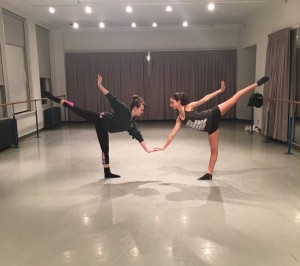Princeton’s Dance Department and Robotics Program might seem like polar opposites to the average student: The former attracts the most creative and artistically inclined of the student body while the latter is deeply math-science oriented. Over the past three weeks, however, I have seen one student challenge these assumptions by bridging the arts-science divide.
Dana Fesjian ’17 is an undergraduate in the Electrical Engineering (ELE) Department, who is participating in a Lewis Center for the Arts initiative called Performance Lab. Known informally as P-Lab, this initiative allows dancers to explore independent work that connects dance with a different field. The culmination of this exploration is a performance in early March where the participants showcase their choreography and explain their independent work. Dana—whom I dance with in Princeton University Ballet—is using sound-sensitive robots to create dance movements and patterns that will eventually be performed by humans. She asked me to be one of the dancers in her project and I happily agreed to do so.

Throughout our rehearsals over the past three weeks, I have had the chance to learn more about Dana’s independent work, and decided to cover her experience for my post this week.
Me: Can you tell us about this robotics project and how you got involved with it?
Dana: Last fall, I emailed Naomi Leonard, a professor in the Mechanical and Aerospace Engineering (MAE) Department because another student had told me that she loved exploring the intersections of dance and engineering, which is pretty rare for an MAE professor. I connected with her and asked if I could do an independent project choreographing dance with robots. She agreed to be my adviser and connected me with a grad student interested in similar work.
We designed a project in which we directed robots to move in a certain way according to a control law. I programmed the robots to interpret sound inputs and react differently depending on a song’s decibel level or keynote.
Me: Once you had developed this project, how did you decide that you wanted to incorporate it into your work in the Dance Program?

Dana: I heard about P-Lab from Tina Fehlandt, a professor in the Dance Program, who told me about it when I explained that I was simulating dances with robots for an independent project. That was when I realized that I could actually turn my project into a dance instead of just a simulation. I decided to use six songs of different genres to choreograph dances on robots and then stage those dances on people.
Me: How is this research project different from ones you have done before?
Dana: Unlike most of the projects I do, it is hard to quantify this one because of the dance and aesthetic aspects. It’s challenging because I’m usually supposed to get one solid result with every experiment I do, but with this it’s different because anything could be the outcome and any outcome could be okay. Choosing the best outcome is subjective rather than objective, which gives me a lot more responsibility when I’m designing the experiments.
“It’s challenging because I’m usually supposed to get one solid result with every experiment I do, but with this it’s different because anything could be the outcome and any outcome could be okay.”
Me: What have you liked most about this process?
Dana: I’m really passionate about bridging the gap between the sciences and the arts, which is not something that most people ever consider. I’m glad that I could make this project into a performance for people from across disciplines to see. I’ll be able to show my colleagues in the Dance and Robotics Programs how I’ve surpassed the boundaries of both disciplines to create something complex and innovative.
Me: Do you have any major take-aways from this process? How will it change the way you approach future research projects?
Dana: My experience with P-Lab has caused me to be more creative when solving questions in my ELE classes. From a dance perspective, it’s made me more methodical about how I approach choreography. My overall goal was to figure out new ways that dancers could use robots to choreograph and to expose everyone to ways we can combine things that don’t usually go together to solve problems. Working on the project has shown me how exciting this process can be, so I plan on further pursuing this interdisciplinary effort in my future work.
~~~
The P-Lab showings, which are open to the public, are on the evenings of March 3 and 4. If you are interested in learning more about P-Lab or attending the showing, you can find more information here.
–Emma Kaeser, Social Sciences Correspondent

